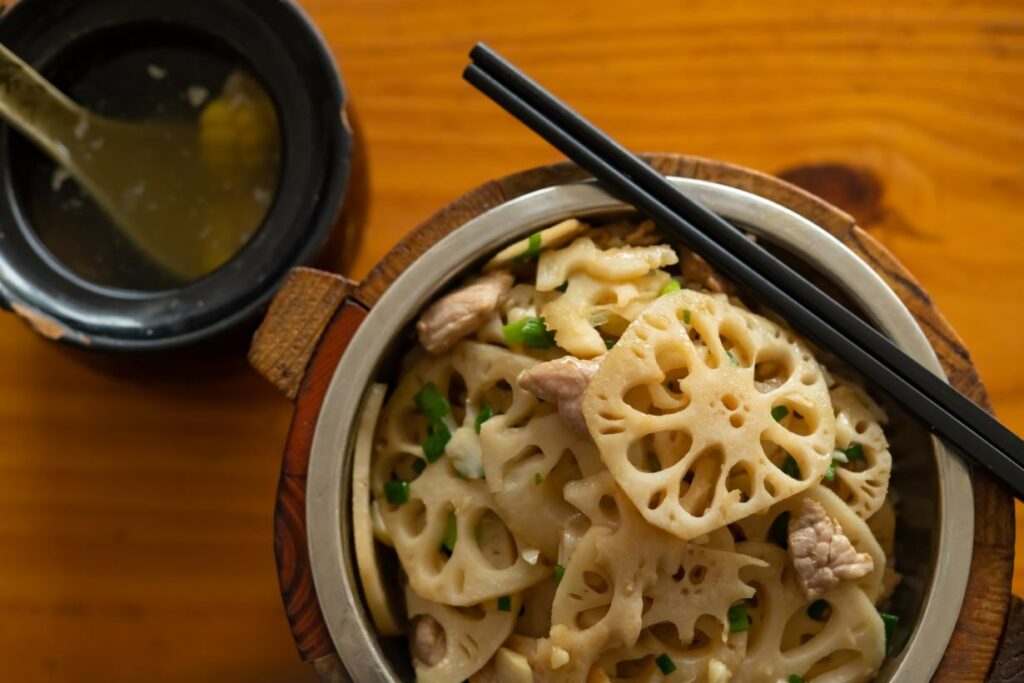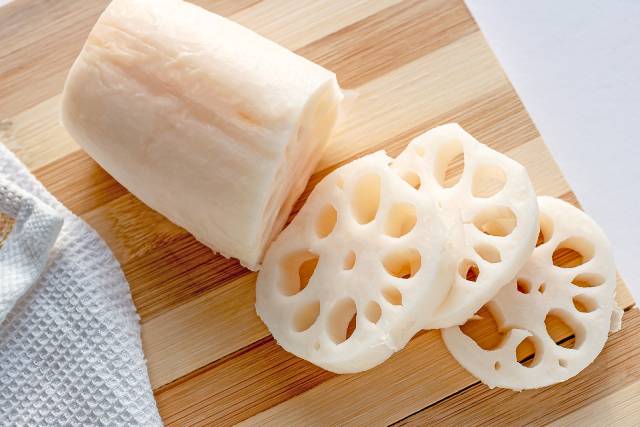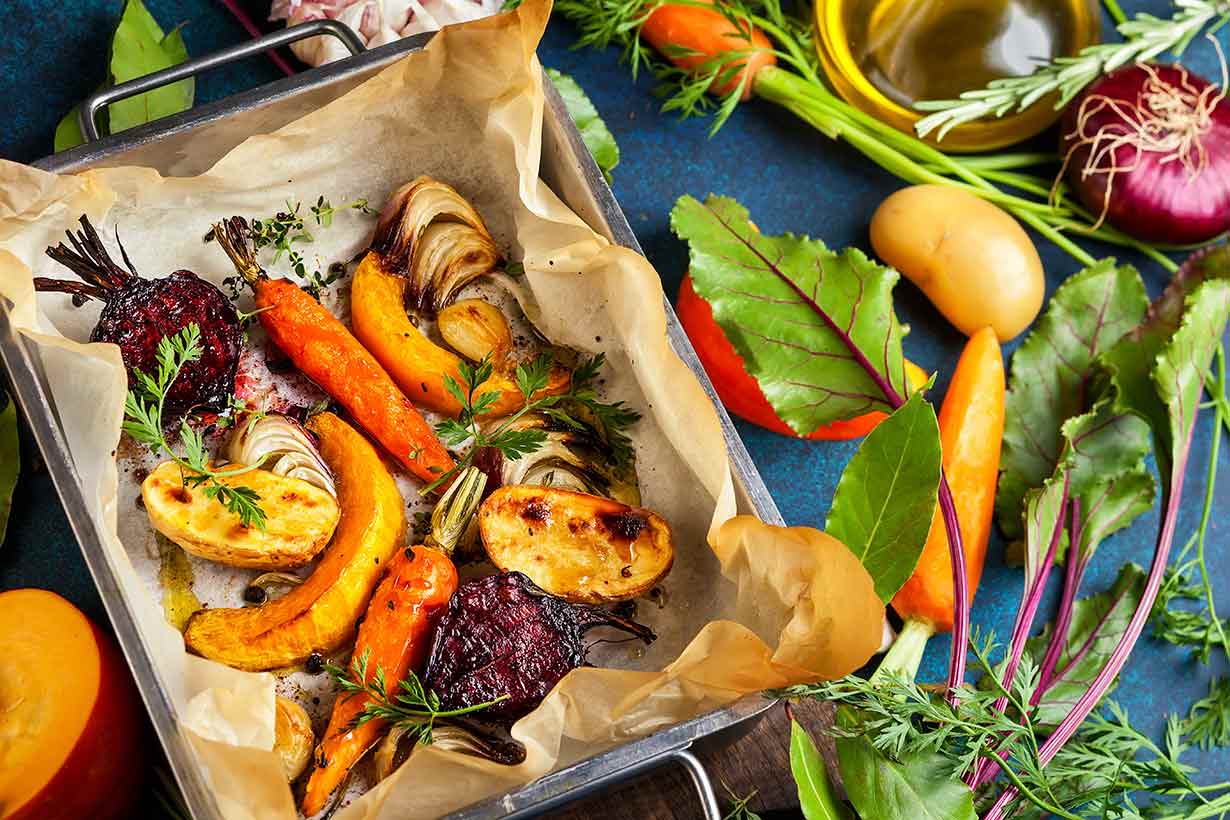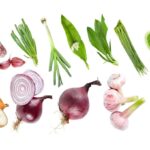Lotus root is a root vegetable with a crunchy and flavorful taste.
However, what exactly is lotus root, and what does it provide nutritionally?
This article provides a guide to lotus root’s nutritional benefits and characteristics.
Table of contents
What Is Lotus Root?

Known scientifically as ‘Nelumbo nucifera,’ lotus root is the underground rhizomes of the lotus plant. The word ‘rhizome’ refers to the underground horizontal stems of a plant (1, 2).
Lotus is an aquatic plant that grows in bodies of water worldwide. However, it tends to be more prevalent in India and East Asian countries.
Lotus root enjoys wide use as a vegetable in Asian countries, and it is particularly popular in Chinese, Indian, Japanese, and Korean cuisine. In addition, it is commonly used in soups and stews or marinated and served as a side dish.
As a starchy vegetable, lotus root has a moderate carbohydrate content. It also has a crunchy texture that somewhat resembles a raw potato, even after being cooked.
Lotus root has a mildly sweet, flavorful taste. It has a flavor slightly like water chestnuts but with a taste of its own.
In addition to its use as a vegetable, numerous lotus root products are available. One popular example of this is lotus root tea.
Benefits of Lotus Root
There is very little research on the effects of lotus root in controlled studies involving human participants.
However, based on its characteristics and nutritional properties, here are some benefits of lotus root.
High In Vitamin C
Lotus root provides a good amount of vitamin C, an essential nutrient that plays a vital role in the immune system (1, 2).
Per 3.5 oz (100-gram) cooked serving, lotus root provides 27.4 mg of vitamin C. This amount equals 30% of the daily value of vitamin C (3, 4).
A Good Source of Copper
Copper is another essential nutrient present at high levels in lotus root.
Per 3.5 oz (100-gram) serving, cooked lotus root offers 0.22 mg of copper, equal to 24% of the recommended daily value (3, 4).
Among its many functions, copper is vital for brain development, energy production, and ensuring the proper functioning of the immune system (5).
Contains Soluble Fiber
Per 3.5 oz (100-gram) serving, cooked lotus supplies approximately 3.1 grams of dietary fiber (3).
This fiber content of lotus root includes soluble fiber, which can have several potentially beneficial health effects. Among these, soluble fiber can lower levels of LDL-C (sometimes referred to as “bad cholesterol”) (6, 7).
High Polyphenol Levels
Polyphenols are bioactive compounds in plants that may benefit human health (8, 9, 10).
On this note, lotus root contains a range of polyphenols, including gallic acid, catechin, epicatechin, gallic acid, and gallocatechin (11, 12, 13).
The Whole Lotus Plant Is Edible
Another unique benefit of lotus, in general, is that the whole plant is edible.
Although this fact is irrelevant if buying packaged lotus root by itself, the roots, leaves, seeds, and even flowers of lotus plants can be eaten (14, 15).
Nutrition Facts
Here are the nutritional values for cooked lotus root per 3.5 oz (100-gram) serving.
All nutritional data is sourced from the USDA’s FoodData Central database (3). Daily values (% DV) have been calculated using the USDA data alongside the FDA’s daily values (4).
| Name | Amount | % Daily Value |
|---|---|---|
| Calories | 66 kcal | |
| Carbohydrates | 16.0 g | 5.8% DV |
| Fiber | 3.1 g | 11.1% DV |
| Sugars | 0.5 g | |
| Fat | 0.07 g | 0.1% DV |
| Saturated | 0.02 g | 0.1% DV |
| Monounsaturated | 0.01 g | |
| Polyunsaturated | 0.01 g | |
| Omega-3 | 0.001 g | |
| Omega-6 | 0.01 g | |
| Protein | 1.58 g | 3% DV |
| Cholesterol | 0 mg | 0% DV |
Vitamins
| Name | Amount | % Daily Value |
|---|---|---|
| Choline | 25.3 mg | 4.6% DV |
| Folate | 8 mcg | 2% DV |
| Vitamin A, RAE | 0 mcg | 0% DV |
| Vitamin B1 (thiamin) | 0.127 mg | 10.6% DV |
| Vitamin B2 (riboflavin) | 0.01 mg | 0.8% DV |
| Vitamin B3 (niacin) | 0.3 mg | 1.9% DV |
| Vitamin B5 (pantothenic acid) | 0.302 mg | 6% DV |
| Vitamin B6 | 0.218 mg | 12.8% DV |
| Vitamin B12 | 0 mcg | 0% DV |
| Vitamin C | 27.4 mg | 30.5% DV |
| Vitamin D | 0 mcg | 0% DV |
| Vitamin E | 0.01 mg | 0.1% DV |
| Vitamin K | 0.1 mcg | 0.1% DV |
Minerals
| Name | Amount | % Daily Value |
|---|---|---|
| Calcium | 26 mg | 2% DV |
| Copper | 0.217 mg | 24.1% DV |
| Iron | 0.9 mg | 5% DV |
| Magnesium | 22 mg | 5.2% DV |
| Manganese | 0.22 mg | 9.6% DV |
| Phosphorus | 78 mg | 6.2% DV |
| Potassium | 363 mg | 7.7% DV |
| Selenium | 0.6 mcg | 1.1% DV |
| Sodium | 45 mg | 2.0% DV |
| Zinc | 0.33 mg | 3.0% DV |
Does Lotus Root Have Any Downsides?
There do not appear to be any unique adverse effects from lotus root consumption. However, like with all foods, rare allergic reactions from lotus root may be possible for some individuals.
For instance, a case study published in 2020 described a case of anaphylaxis (severe allergic reaction) in a 29-year-old Japanese man following lotus root intake (16).
In 2018, a case published in the Allergology International journal described the ‘identification of a novel food allergen in lotus root’ (17).
Despite this, it is important to note that reports of lotus root allergies are extremely rare. There are minimal reports of cases in the scientific literature.
How To Use Lotus Root
Before cooking, lotus root should be sliced into smaller pieces, as shown in the image below:

Once sliced, lotus root must boil for fifteen to twenty minutes until slightly more tender (it will still be crunchy).
There are several ways of using lotus root:
- In soups, stews, and stir-fries: lotus root can be a delicious addition to cooked dishes, providing extra flavor and a crunchy texture. This recipe explains how to make a stir-fried lotus root dish.
- Marinated and served as a side dish: popular marinated lotus root recipes involve marinating the lotus root slices in ingredients including soy sauce and sesame oil. This recipe for braised lotus root is a popular example.
- Fried chips: some people also like to make lotus root chips.
Where To Buy Lotus Root
Lotus root isn’t a commonly consumed vegetable in most Western countries. For this reason, it may be hard to find in a typical grocery store.
However, lotus root is widely available in Asian grocery stores, particularly those focused on Chinese, Japanese, or Korean food.
It is usually available to buy in fresh (root) and frozen (pre-sliced) forms, which are nutritionally identical.
Common Questions
Here are the answers to some commonly asked questions about lotus root.
No, the taste of lotus root and potatoes is quite different. Lotus root has a similar texture and ‘crunch’ as raw potatoes, and both vegetables are a source of starchy carbohydrates, but that is where the similarities end.
Lotus root should be cooked before consumption.
Yes, lotus root can be frozen. It is even possible to buy frozen packaged lotus root that has been pre-boiled.
The cooking time of lotus root depends on how thinly sliced the root is. Slices are typically around one centimeter thick, and this size takes around fifteen minutes to boil. However, cooking time may be as little as five minutes for stir-fry recipes. When ready, lotus root will become softer, but it retains its crunchy texture even after cooking.
Final Thoughts
As this article shows, lotus root is a nutritious and versatile vegetable that we can use in various ways.
The main nutritional benefits of lotus root are its fiber, vitamin C, and copper content.
Although it isn’t commonly used in some countries, it is relatively easy to find and adds a nice flavor (and crunch) to dishes.








